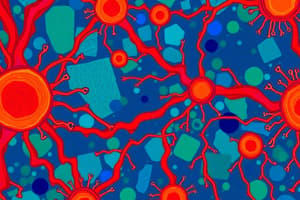Podcast
Questions and Answers
Which hormone from the pituitary gland primarily stimulates the adrenal cortex to produce glucocorticoids?
Which hormone from the pituitary gland primarily stimulates the adrenal cortex to produce glucocorticoids?
- Adrenocorticotropic hormone (correct)
- Luteinizing hormone
- Thyroid-stimulating hormone
- Prolactin
What is a characteristic feature of lipophilic signaling molecules?
What is a characteristic feature of lipophilic signaling molecules?
- They require a transport protein in the bloodstream. (correct)
- They are typically larger in molecular size.
- They cannot pass through the cell membrane.
- They bind to receptor proteins on the cell surface.
How do hydrophilic signaling molecules typically exert their effects on target cells?
How do hydrophilic signaling molecules typically exert their effects on target cells?
- They alter nuclear gene expression directly.
- They degrade intracellular signaling proteins.
- They enter the cell and bind to nuclear receptors.
- They activate second messenger systems inside the cell. (correct)
Which statement best describes hormone-receptor complexes?
Which statement best describes hormone-receptor complexes?
What role does the endocrine system play in regulating metabolic processes?
What role does the endocrine system play in regulating metabolic processes?
Which statement about cell-surface receptors is accurate?
Which statement about cell-surface receptors is accurate?
Which of the following correctly classifies signaling molecules based on their solubility?
Which of the following correctly classifies signaling molecules based on their solubility?
How do hormone-receptor complexes influence cellular activity?
How do hormone-receptor complexes influence cellular activity?
What role does the pituitary gland play in the endocrine system?
What role does the pituitary gland play in the endocrine system?
Which feature distinguishes hydrophilic signaling molecules from lipophilic ones?
Which feature distinguishes hydrophilic signaling molecules from lipophilic ones?
Which type of signaling molecule is likely to pass through the cell membrane easily due to its lipid solubility?
Which type of signaling molecule is likely to pass through the cell membrane easily due to its lipid solubility?
What is the primary role of the pituitary gland in the context of hormone regulation?
What is the primary role of the pituitary gland in the context of hormone regulation?
What is formed when a hormone binds to its specific receptor on a target cell?
What is formed when a hormone binds to its specific receptor on a target cell?
Which molecule is likely to elicit a rapid cellular response due to its characteristics?
Which molecule is likely to elicit a rapid cellular response due to its characteristics?
How do lipophilic signaling molecules primarily exert their effects in target cells?
How do lipophilic signaling molecules primarily exert their effects in target cells?
Which mechanism best describes how the endocrine system maintains homeostasis?
Which mechanism best describes how the endocrine system maintains homeostasis?
What distinguishes lipophilic prostaglandins from other signaling molecules?
What distinguishes lipophilic prostaglandins from other signaling molecules?
Which of the following is a correct statement regarding paracrine signaling molecules?
Which of the following is a correct statement regarding paracrine signaling molecules?
Which characteristic is NOT typically associated with lipophilic signaling molecules?
Which characteristic is NOT typically associated with lipophilic signaling molecules?
In what way do lipophilic signaling molecules typically influence target cells?
In what way do lipophilic signaling molecules typically influence target cells?
What is an exception to the general behavior of lipophilic signaling molecules?
What is an exception to the general behavior of lipophilic signaling molecules?
What is the primary function of G protein-linked receptors upon ligand binding?
What is the primary function of G protein-linked receptors upon ligand binding?
What is the result of G protein activation in relation to enzymes?
What is the result of G protein activation in relation to enzymes?
Which component does G protein activation primarily interact with to effect changes?
Which component does G protein activation primarily interact with to effect changes?
Which molecule is generated as a result of enzyme activation by G proteins?
Which molecule is generated as a result of enzyme activation by G proteins?
What aspect of membrane potential can be affected by G protein-linked receptors?
What aspect of membrane potential can be affected by G protein-linked receptors?
Flashcards are hidden until you start studying
Study Notes
Cell-Surface Receptors
- Cells can have multiple receptors for the same ligand.
- Signaling molecules are produced by cells and target cells that contain receptors for that specific molecule.
- Prostaglandins are lipophilic and diffuse across the plasma membrane, interacting with intracellular receptors in the cytosol or nucleus.
- The hormone-receptor complex often binds to DNA regions to influence gene transcription.
- An example of a cell-surface receptor mediated process is Ca2+ homeostasis.
- Changes in Ca2+ levels in the body can cause different medical conditions such as osteoporosis or hypoparathyroidism.
- Osteoblasts build bone, an essential part of Ca2+ homeostasis.
G Protein-Linked Receptors
- G protein-linked receptors are activated by ligands, triggering the activation of G proteins (guanyl nucleotide (GTP)-binding proteins).
- G proteins can either activate or inhibit enzymes that generate specific second messengers or ion channels, altering membrane potential.
- Cyclic AMP (cAMP) and cyclic GMP (cGMP) are second messengers derived from ATP and GTP by the action of adenylate cyclase and guanylate cyclase, respectively.
- Glucagon's action is mediated through cAMP.
Neurotransmitters
- Small molecule neurotransmitters:
- Glutamate
- GABA (γ-aminobutyric acid)
- Glycine
- All amino acids, but GABA is not found in proteins.
Neuropeptides
- Composed of three or more amino acids.
- Larger than small molecule transmitters.
- Numerous different types exist.
Studying That Suits You
Use AI to generate personalized quizzes and flashcards to suit your learning preferences.




